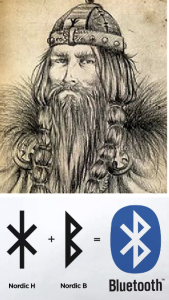Download as a one page, easy to print PDF — > littleclickers-march19
 We all use Bluetooth and WiFi these days. Do you knew the difference? How did Bluetooth get such a funny name? (Hint, it was from a king with a rotten tooth). Let’s learn more.
We all use Bluetooth and WiFi these days. Do you knew the difference? How did Bluetooth get such a funny name? (Hint, it was from a king with a rotten tooth). Let’s learn more.
1. What is the difference between WiFi and Bluetooth? Both are speedy, invisible radio waves. But Bluetooth takes less energy to make and it has a very short range (no more than 30 feet). It is handy for connecting speakers, headphones and toys. WiFi waves carry the Internet to your phone or computer, and they have more power than Bluetooth. Learn more at techopedia http://bitly.com/2J2BBKb
2. How did Bluetooth get it’s name? There actually was a guy with a blue tooth. King Harald “Bluetooth” Gormsson was known for two things — uniting Denmark and Norway in 958 AD, and his dead tooth, which was a dark blue in color. When present day engineers were trying to unite the industry with one standard, they used “bluetooth” as a code name for the project, and the name stuck. Learn more at https://www.bluetooth.com/about-us/bluetooth-origin.
3. Who discovered radio waves? Heinrich Hertz saw an electrical spark that changed the world, after he discovered that it generated a radio wave. The place was Germany, and the year was 1886, according to http://bitly.com/2Tr5K9S. Within the next decade, researchers Nikoli Tesla and Guglielmo Marconi figured out how to transmit sounds over extremely long distances. Learn more at https://www.pbs.org/tesla/ll/ll_early.html
4. Which goes faster, light or radio waves? They travel the same speed — about 186,282 miles per second. In miles per hour that’s 670,616,629 mph, or 7.5 times around the Earth in one second. Learn more at https://www.space.com/15830-light-speed.html
5. Are radio waves dangerous? That’s up for debate. Consider that right now there are many types of radio waves passing through your body. Should you worry? Unless you plan on sticking your head in a microwave oven, you can rest easy, according to the American Cancer Society. Read up on the topic at http://bitly.com/2TxeMC6
APPLICATION: PLAY WITH RADIO WAVES
To understand the idea behind radio waves, it’s fun to start by making an electromagnet. You’ll need a battery, a nail and copper wire. Wrap the wire around the nail, and touch each end of the battery to pick up some paperclips. To make a radio, the easiest way is buy a kit, like this one for $15 from Elenco https://amzn.to/2IQvmIZ.
If you want to see the power of radio waves at work, simply put a small piece of Ivory brand soap in a microwave. The radio waves heat up the tiny bubbles of air to create a rather dramatic effect. Make sure to tell your parents if you put anything unusual in the microwave oven. Learn more at https://www.scienceinschool.org/2009/issue12/microwaves.
Radio Waves on YouTube
Want more? Here’s a video playlist https://www.youtube.com/playlist?list=PLcBVHzUUEKwk7i9KO-Vu8OJXs5j_ouf4C\
———————————————————————————————————————————————— LittleClickers.com (this page and the associated web site) is sponsored by Computer Explorers. Neither Children’s Technology Review (publisher of LittleClickers) or Computer Explorers has any vested interest in any of the sites listed on this page. Librarians and teachers are permitted to copy this page for non-profit use. To report a bad link, use this form, or contact us. Copyright 2018, Children's Technology Review.


